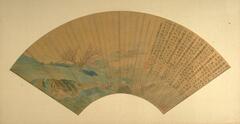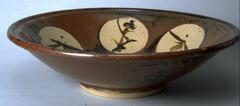10 Items in this Learning Collection
Collection Object
Collection Object
Collection Object
Collection Object
Collection Object
Collection Object
Collection Object
Collection Object
Collection Object
Collection Object
Copyright
All Rights Reserved
()
Monkey Seated on a Wisteria Branch
Accession Number
1986/1.166
Title
Monkey Seated on a Wisteria Branch
Artist(s)
Nagasawa Rosetsu
Object Creation Date
1770s - mid 1780s
Medium & Support
hanging scroll, ink and color on silk
Dimensions
30 7/16 in. x 13 1/8 in. ( 77.3 cm x 33.3 cm )
Credit Line
Museum purchase made possible by the Friends of the Museum of Art
Label copy
Born and raised in the family of a low ranking samurai, Rosetsu was eccentric and violent. He was one of the best of Okyo's pupils and in many ways, one of his most remarkable followers, but was eventually expelled from his studio. Although considered shameful, this separation allowed Rosetsu to develop his own painting style. An extremely versatile artist, he was fluent in many different techniques and a variety of subject matter. The monkey in this work is chewing a wisteria blossom. The animal's witty expression demonstrates the artist's ability to capture a lively aspect of nature.
Subject matter
"This painting is an example of Rosetsu using his skills and training to highlight different styles within his image. He paints in a naturalistic way that focuses on structured qualities found in the , while also combining those functional principles with aesthetic characteristics learned from Chinese literati painting, bunjinga."
"Both lyrical and poetic, the creation of the wisteria branches is reminiscent of Japanese calligraphy, which was often paired with landscape paintings. The branches gracefully wind up and through the painting, their delicate features appearing more majestic then overbearing. This lyricism was a style inspired by Chinese painting tradition."
"Nanga artists developed their own styles by using a variety of brushstrokes to gain new effects. Rosetsu shows a dynamic use of brushwork, especially concerning the way he represents the branches, flowers and leaves. All of the branches are made using thick, dark strokes that show no fine detail. Some areas are thicker then others, such as the trunks at the base of the wisteria plant compared to the branches holding the wisteria flowers. The plant’s dark coloring gives it a sturdy appearance compared to the wispy, white flowers dangling from the branches. The monkey’s fur is quite vibrant and unlike any of the other strokes. Soft and lightly-colored, the fur seems fuzzy, a contrasting texture when compared to the thick branches. The brushstrokes used to create the rings of water are also different. These lines move in and out of one another, creating the effect of rippling waves. These three specific places show a highly contrasted use of brushwork that unites the subject matter within the composition, while simultaneously allowing the artist to evoke his personal style in the image."
Grahl, Carrie. “Monkey Seated on a Wisteria Branch.” Japanese Landscapes, 18 Dec. 2009, japaneselandscape.wordpress.com/literati/naturalist-prints/monkey-seated-on-a-wisteria-branch/.
Physical Description
"Rosetsu uses the wisteria tree to frame the painting and to create two separate planes, the foreground and the background. While doing this, he does not paint a very prominent background, thus making the foreground landscape more important and the focal point of the painting...The sinewy shape of the wisteria dominates the painting. There appear to be two separate trunks rooted to a small sliver of land pictured at the left side of the image. These trunks merge into one stem, forming a curve that snugly holds the monkey’s body. The branch continues upward, disappearing at one point until it reappears, winding around the right side of the painting. Rosetsu uses a dark ink to create the trunk and branches of the wisteria, and there does not appear to be any indication of shading or altering the color to appear lighter. This darkening is especially noticeable compared to the stark, white flowers at the top of the painting. Their stems are soft and wispy, as if they are floating in the air."
Grahl, Carrie. “Monkey Seated on a Wisteria Branch.” Japanese Landscapes, 18 Dec. 2009, japaneselandscape.wordpress.com/literati/naturalist-prints/monkey-seated-on-a-wisteria-branch/.
Primary Object Classification
Painting
Primary Object Type
figure painting
Collection Area
Asian
Rights
If you are interested in using an image for a publication, please visit http://umma.umich.edu/request-image for more information and to fill out the online Image Rights and Reproductions Request Form. Keywords
branches
flower (motif)
flowers
hanging scrolls
ink
monkeys
monkeys (animals)
trees
1986/1.166
Title
Monkey Seated on a Wisteria Branch
Artist(s)
Nagasawa Rosetsu
Object Creation Date
1770s - mid 1780s
Medium & Support
hanging scroll, ink and color on silk
Dimensions
30 7/16 in. x 13 1/8 in. ( 77.3 cm x 33.3 cm )
Credit Line
Museum purchase made possible by the Friends of the Museum of Art
Label copy
Born and raised in the family of a low ranking samurai, Rosetsu was eccentric and violent. He was one of the best of Okyo's pupils and in many ways, one of his most remarkable followers, but was eventually expelled from his studio. Although considered shameful, this separation allowed Rosetsu to develop his own painting style. An extremely versatile artist, he was fluent in many different techniques and a variety of subject matter. The monkey in this work is chewing a wisteria blossom. The animal's witty expression demonstrates the artist's ability to capture a lively aspect of nature.
Subject matter
"This painting is an example of Rosetsu using his skills and training to highlight different styles within his image. He paints in a naturalistic way that focuses on structured qualities found in the , while also combining those functional principles with aesthetic characteristics learned from Chinese literati painting, bunjinga."
"Both lyrical and poetic, the creation of the wisteria branches is reminiscent of Japanese calligraphy, which was often paired with landscape paintings. The branches gracefully wind up and through the painting, their delicate features appearing more majestic then overbearing. This lyricism was a style inspired by Chinese painting tradition."
"Nanga artists developed their own styles by using a variety of brushstrokes to gain new effects. Rosetsu shows a dynamic use of brushwork, especially concerning the way he represents the branches, flowers and leaves. All of the branches are made using thick, dark strokes that show no fine detail. Some areas are thicker then others, such as the trunks at the base of the wisteria plant compared to the branches holding the wisteria flowers. The plant’s dark coloring gives it a sturdy appearance compared to the wispy, white flowers dangling from the branches. The monkey’s fur is quite vibrant and unlike any of the other strokes. Soft and lightly-colored, the fur seems fuzzy, a contrasting texture when compared to the thick branches. The brushstrokes used to create the rings of water are also different. These lines move in and out of one another, creating the effect of rippling waves. These three specific places show a highly contrasted use of brushwork that unites the subject matter within the composition, while simultaneously allowing the artist to evoke his personal style in the image."
Grahl, Carrie. “Monkey Seated on a Wisteria Branch.” Japanese Landscapes, 18 Dec. 2009, japaneselandscape.wordpress.com/literati/naturalist-prints/monkey-seated-on-a-wisteria-branch/.
Physical Description
"Rosetsu uses the wisteria tree to frame the painting and to create two separate planes, the foreground and the background. While doing this, he does not paint a very prominent background, thus making the foreground landscape more important and the focal point of the painting...The sinewy shape of the wisteria dominates the painting. There appear to be two separate trunks rooted to a small sliver of land pictured at the left side of the image. These trunks merge into one stem, forming a curve that snugly holds the monkey’s body. The branch continues upward, disappearing at one point until it reappears, winding around the right side of the painting. Rosetsu uses a dark ink to create the trunk and branches of the wisteria, and there does not appear to be any indication of shading or altering the color to appear lighter. This darkening is especially noticeable compared to the stark, white flowers at the top of the painting. Their stems are soft and wispy, as if they are floating in the air."
Grahl, Carrie. “Monkey Seated on a Wisteria Branch.” Japanese Landscapes, 18 Dec. 2009, japaneselandscape.wordpress.com/literati/naturalist-prints/monkey-seated-on-a-wisteria-branch/.
Primary Object Classification
Painting
Primary Object Type
figure painting
Collection Area
Asian
Rights
If you are interested in using an image for a publication, please visit http://umma.umich.edu/request-image for more information and to fill out the online Image Rights and Reproductions Request Form. Keywords
branches
flower (motif)
flowers
hanging scrolls
ink
monkeys
monkeys (animals)
trees










